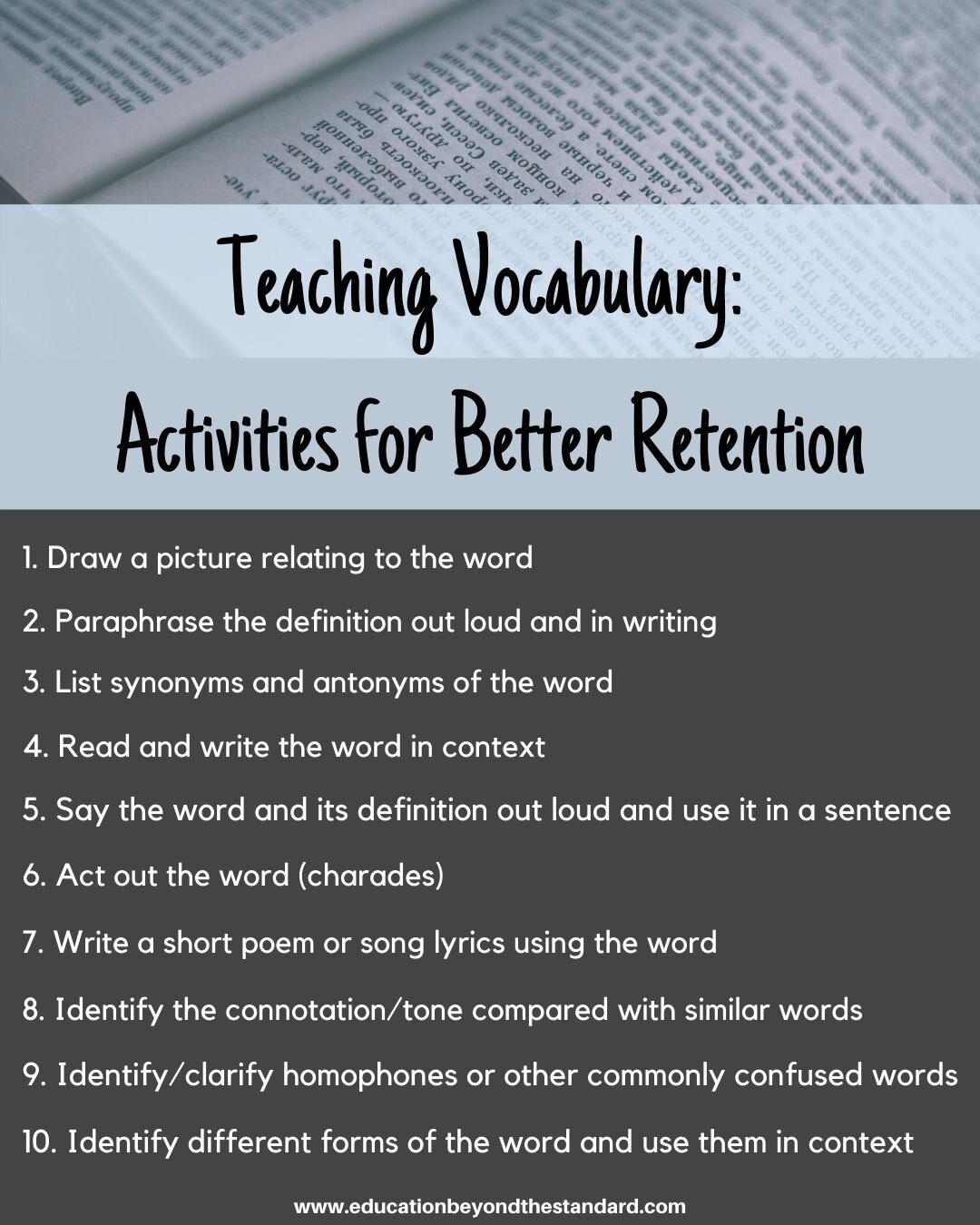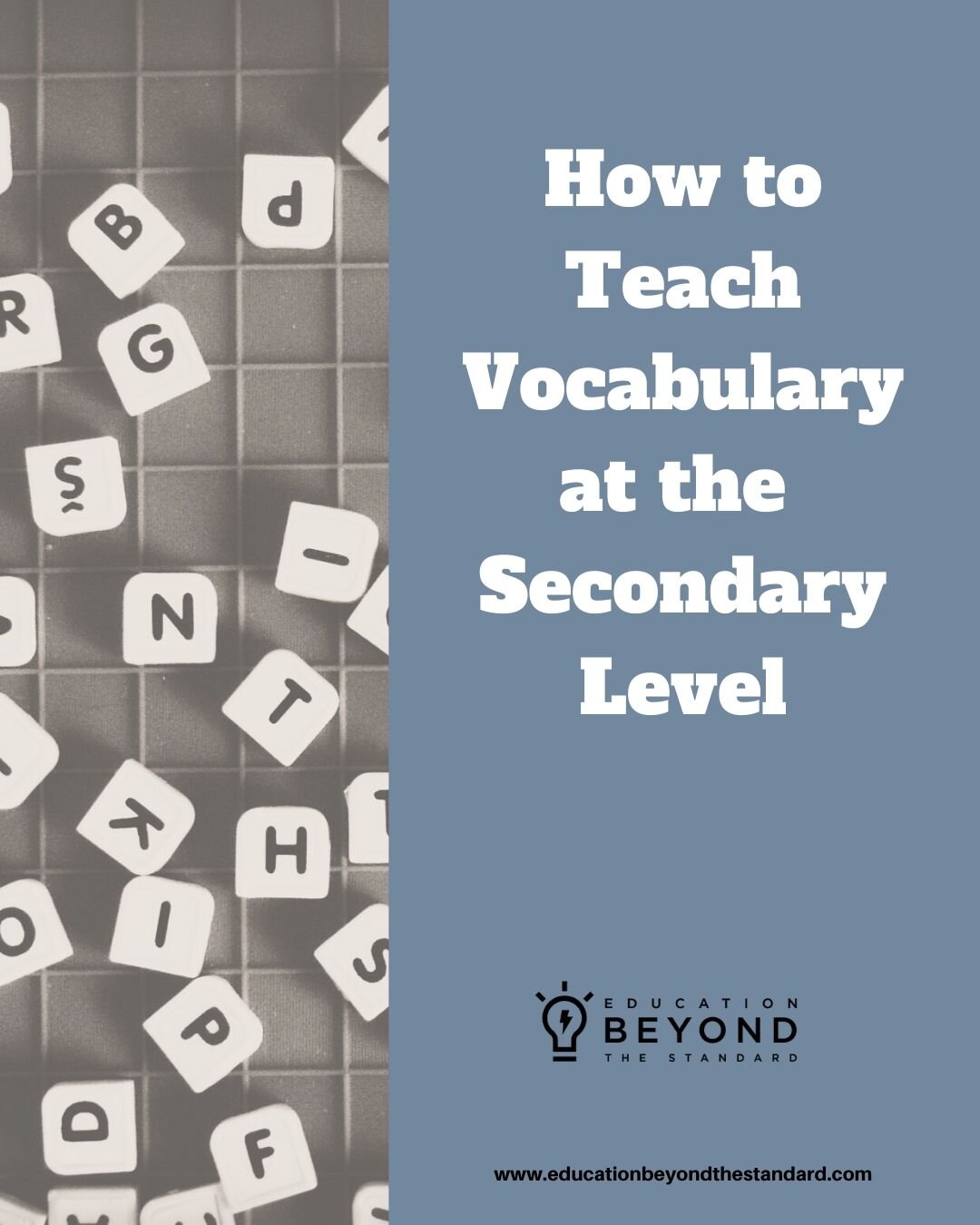How to Teach Vocabulary at the Secondary Level
/With all of the many secondary English curriculum demands, it can be hard for teachers to fit in vocabulary instruction. Fortunately, building effective vocabulary instruction into your classroom can be relatively painless (low prep or no prep) and incredibly beneficial for your students.
Why Teaching Vocabulary Is So Important
Study after study confirms that vocabulary skill Is strongly correlated with academic, vocational, and social outcomes. (ASCD) This is likely due to the fact that vocabulary skill is a major component of reading, writing, and oral communication skills, which all play a significant role in these outcomes.
Vocabulary skill goes much deeper than memorizing definitions of words: it’s about how we use words to convey precise and nuanced meanings, how accurately we interpret meaning in language, and how well we understand the relationships between words.
The Common Core State Standards distinguish academic vocabulary (high-frequency words that may have multiple meanings) and vocabulary in context from domain-specific vocabulary (words that are associated with a specific subject, such as genome or treaty). This focus on high-frequency words and meaning in context is closely aligned with the skills tested on the SAT and ACT and those required for success on the university level.
Whether mandated by standards or not, teaching vocabulary at the secondary level is a powerful tool to improve students’ reading and writing skills, standardized test scores, and overall academic outcomes.
What Makes for Effective Vocabulary Instruction?
In many ways, teaching vocabulary at the middle and high school level is not that different than at the elementary level. Here are some characteristics of effective vocabulary instruction:
Small, manageable word lists (10 or less)
Varied learning methods and activities, including physical movement, visual aids, speaking/listening, reading/writing, drawing a picture, synonyms/antonyms, etc.
A focus on high-frequency words over very specific or technical words (domain-specific and technical words can be taught as needed for lessons on these topics)
An emphasis on context (both understanding words in context and using them correctly in context)
Of course our hope is that when students get to middle and high school they’ve already been exposed to and practiced good vocabulary learning strategies. We also hope that they come to us with grade-appropriate vocabularies. Unfortunately, for a variety of reasons, this may not always be the case. And research shows that the gap between students with broad, grade-appropriate vocabularies and those without tends to grow wider by the year, which makes effective secondary vocabulary instruction even more important.
How to Teach Vocabulary to Middle and High School Students
Be intentional.
There are many excellent stand-alone vocabulary systems that you can implement for a low to no-prep solution. I’ve created this year-long, 200-word vocabulary program, which requires no prep. You can also create your own vocabulary system to work within your novel and nonfiction text studies, although this option requires more planning on your part.
It’s important to evaluate what will work best with your curriculum, standards, and time constraints, and go from there. Both stand-alone vocabulary and vocabulary as part of a fiction or nonfiction text can be very effective, as long as the general principles described above are incorporated.
Find Ways to Discuss/Highlight Words and Word Relationships
Understanding how words relate to one another is a big component of the higher level vocabulary skills that contribute to strong reading and writing skills. Knowing that neutral and indifferent have two different shades of meaning and being able to both identify why an author might choose one over the other and also choose the appropriate word for a given situation are examples of these higher level skills. Use class discussions to highlight different uses of words that achieve a certain tone or connotation. Ask students to come up with synonyms that have a similar tone or connotation.
Choose Word Lists With High-Frequency, Academic Vocabulary Words
If you go with a stand-alone vocabulary system, make sure it emphasizes academic vocabulary. If you choose vocabulary for each novel or text, try to ensure that the words you select are mostly academic vocabulary as opposed to domain-specific vocabulary. Of course if your class is reading a nonfiction text or novel with a heavy focus on a particular subject, you will need to include domain-specific vocabulary words. But generally speaking, students will get more mileage out of having a broader academic vocabulary than a narrow, domain-specific vocabulary.
Encourage Use-In-Context of Vocabulary Words During Class Discussions and Writing Exercises
Students will benefit from as much practice using vocabulary words (and hearing/seeing them used correctly) as possible. One simple way to do this is to keep a class tally on the board for the number of times each vocabulary word is used correctly in context during a class discussion. If a student uses a word incorrectly, it’s a great opportunity to discuss why its use was incorrect and the correction necessary.
Teach Techniques for Understanding the Meaning of Words in Context
While we hope that students learn these techniques in earlier grades, we can’t assume that all of our students will come to us already having this skill. Fortunately, the techniques aren’t too difficult or time consuming to teach and once we do, we can reinforce them throughout the year. I’ve created this no-prep mini unit to teach techniques for understanding vocabulary in context.
Create an Atmosphere of Enthusiasm Around Learning New Words
Give students vocabulary word activities, discuss words and their shades of meaning, and play vocabulary games to make vocabulary learning a lot more interesting and interactive than memorizing a word list. Here is a vocabulary bingo game I created that use homophones and frequently confused words (middle school edition). Of course students need to know the definitions of new words, but make it clear that that’s not the only goal, nor the most important. Improving our language abilities holistically is actually enjoyable and if we share that attitude from the start students will catch it too.
What strategies and methods have worked well in your classrooms? I’d love to hear from you in the comments below!



